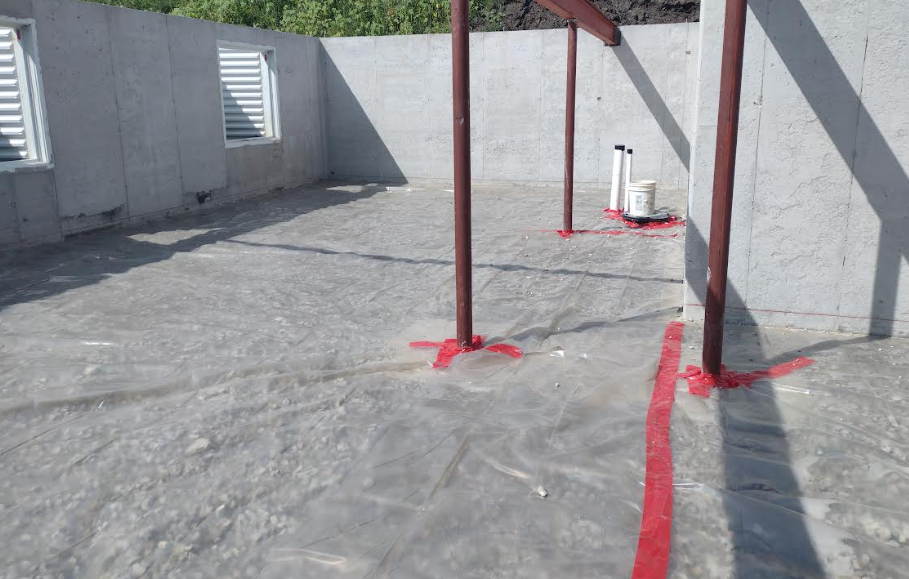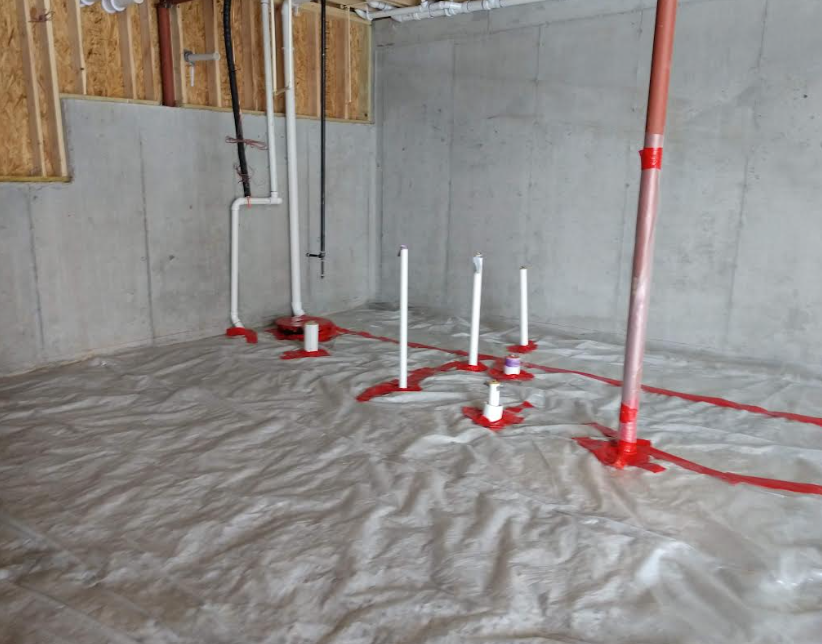
If you’re pouring a concrete slab under a conditioned space, the vapor retarder beneath slab code requirements in the 2021 IRC mandate a vapor barrier—and not just any plastic sheet.
The 2021 IRC made an important change: under Section R506.2.3, the minimum vapor retarder thickness was increased from 6 mils to 10 mils.
Why the change? Because 6-mil barriers were too easily punctured or damaged during construction, reducing their effectiveness. A 10-mil vapor retarder provides much greater durability, especially in high-traffic slab prep areas.
Here’s what the code now says:
“A 10-mil (0.010 inch) polyethylene or approved vapor retarder conforming to ASTM E1745 Class A shall be placed between the base course or subgrade and the concrete slab.” (IRC R506.2.3)
But thickness isn’t the only thing that matters.
Sealing the Vapor Retarder Around Pipes, Conduits, and Sump Pits

A vapor retarder only works if it’s continuous. Any holes, cuts, or penetrations must be sealed to prevent moisture migration. This includes:
- Plumbing drain lines
- Electrical conduit
- Sump pump pits or ejector pits
- Radon vent pipes
“The vapor retarder shall be sealed around all penetrations and at all seams to maintain continuity.”
This isn’t optional—it’s a recognized industry standard, and vapor barrier manufacturers require sealing to maintain product warranties and performance. Per IRC Section R104.11, manufacturer installation instructions carry the weight of code.
In short: if the manufacturer requires sealing around pipes and pits (and they do), the code requires it too.
Why Sealing Matters (and What Happens if You Don’t)
Failing to seal the vapor barrier around penetrations undermines its entire purpose. Unsealed openings become pathways for moisture vapor to migrate into the slab and the conditioned space above.
- Moisture buildup in flooring materials (cupping, warping, adhesive failure)
- Increased risk of mold and mildew under flooring systems
- Elevated indoor humidity leading to HVAC inefficiency
- Potential structural deterioration over time
In a basement or slab-on-grade conditioned space, this moisture migration can turn into a major indoor air quality and durability issue.
That’s why sealing around penetrations isn’t just a recommendation—it’s critical.
How to Seal Around Penetrations
- Use prefabricated pipe boots or pipe collars provided by the vapor barrier manufacturer.
- Seal edges with compatible vapor barrier tape or mastic—follow manufacturer specs to maintain compliance.
- Patch any cuts or tears immediately before the concrete pour.
- Around sump/ejector pits, wrap the barrier up and over the lip and seal to the pit flange using compatible adhesive tape or caulk.
Failing to seal these critical points is one of the most common oversights inspectors catch in slab inspections—don’t let it be yours.
Is a Vapor Barrier Required Everywhere?
Under IRC R506.2.3, a vapor retarder is required beneath all concrete slabs that will be covered with interior finishes (such as flooring materials) or are located under conditioned spaces. However, local codes may expand upon or modify this requirement—always check with your Authority Having Jurisdiction (AHJ).
In crawl spaces, the IRC requires similar moisture protection under Section R408.3 for unvented crawl spaces.
Bottom line: under any conditioned space, a continuous, sealed vapor barrier is mandatory.
Why Vapor Retarder Beneath Slab Code Requirements Matter
The increase from 6 mil to 10 mil wasn’t arbitrary—it reflects a need for greater durability and long-term performance. But a thicker vapor barrier won’t help if it’s full of unsealed penetrations.
The IRC and ASTM standards work together to ensure moisture stays out of your conditioned space. Installing a 10-mil ASTM E1745 Class A vapor retarder and sealing every penetration is the code-compliant—and common-sense—approach to protect your investment.
Learn more: Understanding ASTM E1745 explains the classifications, testing methods, and why this standard is critical for beneath-slab vapor retarders.
Remember: if the manufacturer requires it, the code requires it. And your inspector will too.
In summary, the vapor retarder beneath slab code requirements in the 2021 IRC ensure moisture protection when installed and sealed correctly.
Want to avoid common mechanical code violations on your project? Check out my AC inspection checklist and code tips.